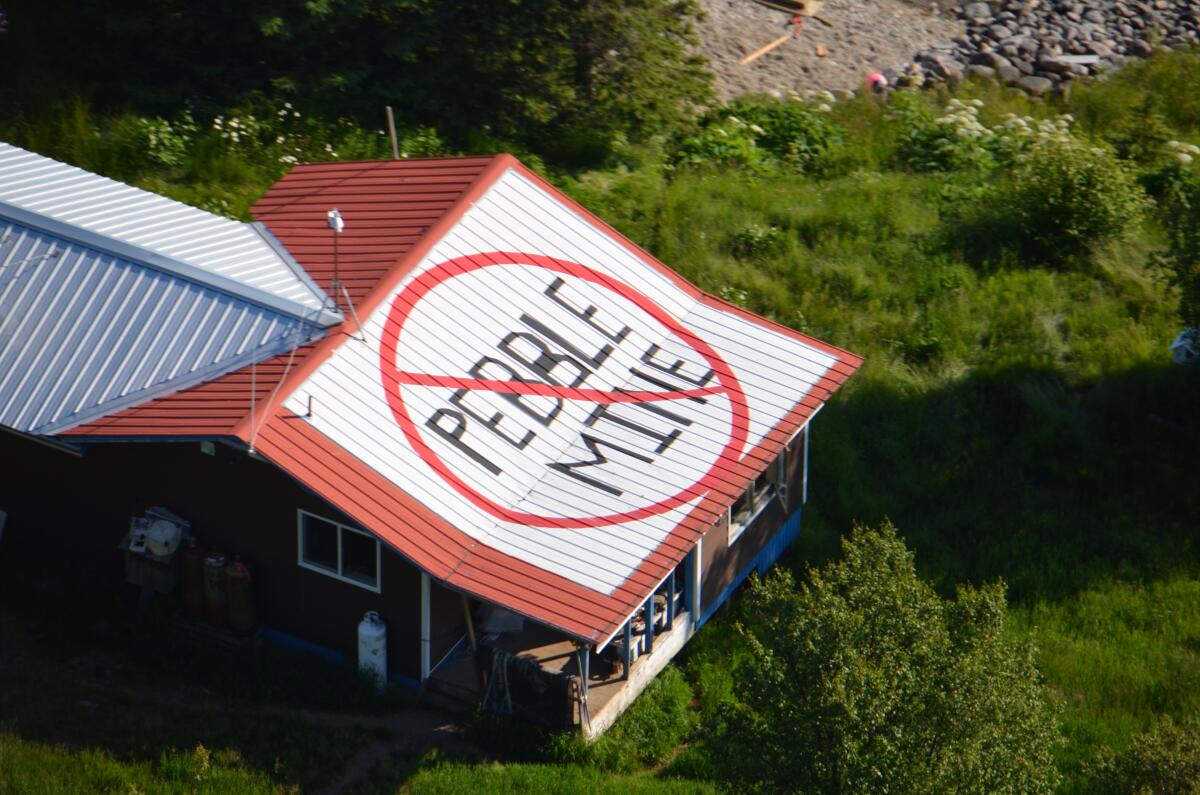Will pristine Bristol Bay be the Trump administration’s next sacrifice?

- Share via
Even by the vanishingly low ethical and environmental standards of the Trump administration, the proposed Pebble Mine project in Alaska stands out for its shamelessness.
Southwest Alaska’s Bristol Bay region, which would be irrevocably upended if the mine were to be built, is the last major fully functional salmon ecosystem in North America. All the others, on both coasts, have mostly or entirely succumbed to logging, mining, farming, ranching, damming, overfishing and development.
But Bristol Bay is still pristine, and as a result it possesses one of the last great wild salmon fisheries on Earth. It annually produces about half of the world’s sockeye, among the most highly valued salmon types. Although many fisheries throughout the world have crashed, Alaska’s Department of Fish and Game reported a total Bristol Bay salmon run last year of 62.3 million fish — an all-time record.
Most of Bristol Bay’s 7,000 residents are Alaska Natives who maintain a subsistence economy that has existed for at least 4,000 years; they embody some of the last intact salmon-based cultures in the world. Alannah Hurley, executive director of the United Tribes of Bristol Bay, calls Pebble Mine an “existential” threat to the Natives’ way of life.
About half of Bristol Bay’s salmon generation occurs in the two largest of its six watersheds, the Nushagak and Kvichak river basins, which, to their residents’ misfortune, are intertwined with a massive copper deposit. If built to its maximum, the mine, which also would produce gold and molybdenum, would cover an area larger than Manhattan.
In response to a petition filed by Bristol Bay Native groups arguing that the mine would violate the Clean Water Act, the Obama-era Environmental Protection Agency conducted a three-year, peer-reviewed scientific assessment published in 2014. It concluded that the mine and its vast infrastructure would “jeopardize the long-term health and sustainability of the Bristol Bay ecosystem,” and proposed rigorous salmon protections that the project couldn’t meet.
But the Trump administration gave Pebble new life. According to a CNN report, an hour after Tom Collier, Pebble Limited Partnership’s CEO, met with then-EPA Administrator Scott Pruitt in May 2017, Pruitt directed his agency to withdraw the protections, without consulting EPA scientists. The protections were later reinstated, then ultimately abandoned to allow a more typical environmental impact and permitting process to go forward.
In December 2017, Pebble Limited Partnership and its Canadian parent company, Northern Dynasty Minerals, filed for permits for a revised mine configuration that would recover only about 15% of the mineral deposit. The U.S. Army Corps of Engineers then gave itself an unusually short one-year deadline to prepare a draft environmental impact statement. (The EIS for another southwest Alaska project, the Donlin Mine, took five years.) The fast-tracked process could allow completion of the permitting before the end of Trump’s term in January 2021.
Not surpisingly, the draft EIS, published in February, was missing key data and analysis, according to David Chambers, president of the Center for Science in Public Participation, which provides technical support to tribal groups facing mining projects. The EPA’s Seattle regional administrator agreed, saying the impact statement “would benefit from being corrected, strengthened, or revised”; it “likely underestimates” the project’s “impacts and risks.” The Department of the Interior and U.S. Fish and Wildlife said much the same thing.
On top of this, the mine plan the Army agency studied might understate the intended size of the project. The massive original footprint drew so much criticism that major investors dropped out after spending more than half a billion dollars on exploration. But the smaller Pebble Mine strikes some financial analysts as infeasible, since the ore generated from it wouldn’t justify the huge cost of building it — estimates top $10 billion. Instead, opponents fear, the permits will lure investors back in, and the reduced mine will become the first phase of a gigantic one.
In the CNN report on the mine in 2017, Collier made a ludicrous claim: Pebble Mine would have no adverse impact on Bristol Bay. The project would transform the region.
Even the downsized mine would include an open pit nearly 2,000 feet deep, tailings dams and holding pits for 1.1 billion tons of waste removed from the deposit, a 188-mile-long natural gas pipeline, 77 miles of new roads, a ferry system on Alaska’s biggest lake, a new coastal port and a new power plant — all in an area where almost nothing of the sort now exists.
In 2014, the EPA estimated that a mine one-eighth the size of the company’s smallest-known plans would devastate streams where salmon spawn and are reared, and that seepage through the region’s porous soil would spread acidic waste contaminants throughout the watersheds. Earthquakes could collapse tailings pits, which would require monitoring and water treatment in perpetuity — considerably longer than the 20 years the company says it plans to operate Pebble Mine.
The draft EIS drew hundreds of thousands of negative critiques from experts and members of the public during the review period. But that kind of reaction hasn’t deterred the Trump administration from its almost gleeful override of environmental protections in pursuit of transient corporate wealth. The drive is so single-minded that its members seem to compete to see who can destroy the most precious natural resource.
If greed swallows Bristol Bay, nothing is off limits.
Jacques Leslie is a contributing writer to Opinion.
More to Read
A cure for the common opinion
Get thought-provoking perspectives with our weekly newsletter.
You may occasionally receive promotional content from the Los Angeles Times.









